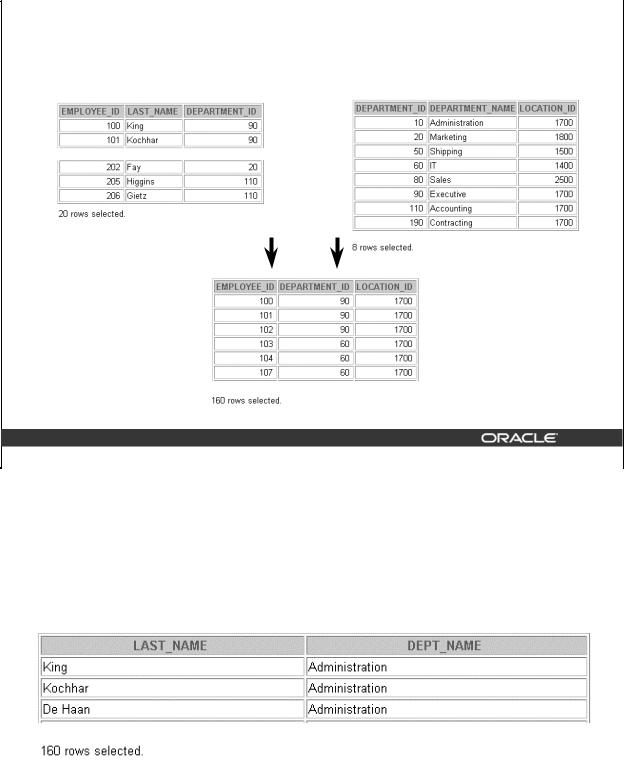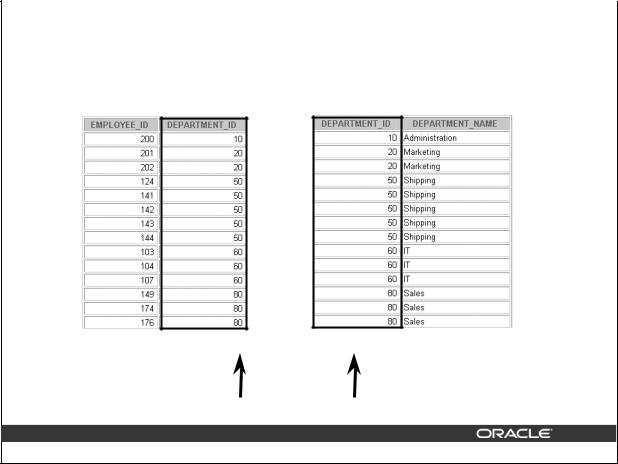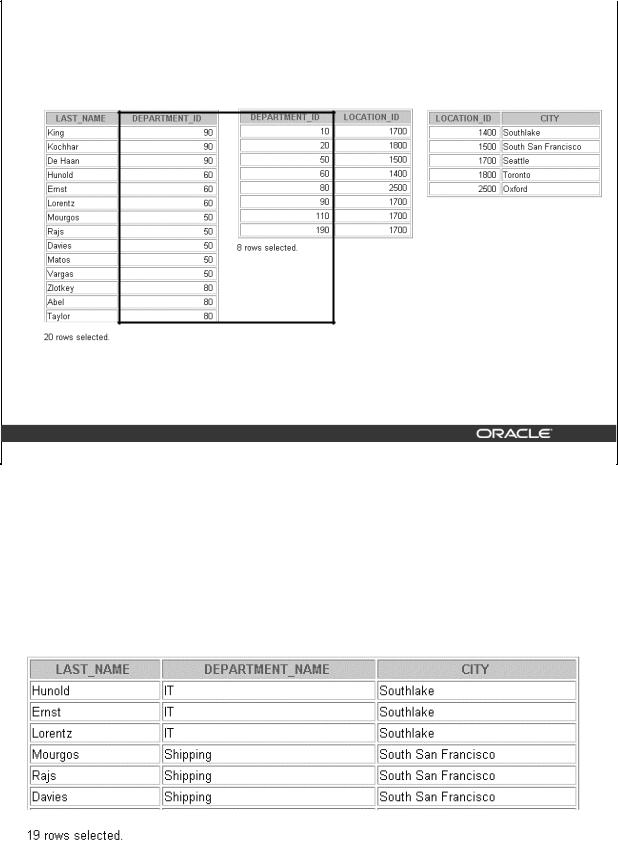
Semestr2 / 1 - Oracle / Student_1-8
.pdf
Generating a Cartesian Product
EMPLOYEES (20 rows) |
DEPARTMENTS (8 rows) |
…
Cartesian product: 
20x8=160 rows
…
4-5 |
Copyright © Oracle Corporation, 2001. All rights reserved. |
Cartesian Products (continued)
A Cartesian product is generated if a join condition is omitted. The example on the slide displays employee last name and department name from the EMPLOYEES and DEPARTMENTS tables. Because no WHERE clause has been specified, all rows (20 rows) from the EMPLOYEES table are joined with all rows (8 rows) in the DEPARTMENTS table, thereby generating 160 rows in the output.
SELECT last_name, department_name dept_name
FROM employees, departments;
…
Introduction to Oracle9i: SQL Basics 4-5

Types of Joins
Oracle Proprietary Joins (8i and prior):
•Equijoin
•Non-equijoin
•Outer join
•Self join
SQL: 1999
Compliant Joins:
•Cross joins
•Natural joins
•Using clause
•Full or two sided outer joins
•Arbitrary join conditions for outer joins
4-6 |
Copyright © Oracle Corporation, 2001. All rights reserved. |
Types of Joins
The Oracle9i database offers join syntax that is SQL: 1999 compliant. Prior to the 9i release, the join syntax was different from the ANSI standards. The new SQL: 1999 compliant join syntax does not offer any performance benefits over the Oracle proprietary join syntax that existed in prior releases.
Introduction to Oracle9i: SQL Basics 4-6

Joining Tables Using Oracle Syntax
Use a join to query data from more than one table.
SELECT table1.column, table2.column
FROM table1, table2
WHERE table1.column1 = table2.column2;
•Write the join condition in the WHERE clause.
•Prefix the column name with the table name when the same column name appears in more than one table.
4-7 |
Copyright © Oracle Corporation, 2001. All rights reserved. |
Defining Joins
When data from more than one table in the database is required, a join condition is used. Rows in one table can be joined to rows in another table according to common values existing in corresponding columns, that is, usually primary and foreign key columns.
To display data from two or more related tables, write a simple join condition in the WHERE clause.
In the syntax:
table1.column |
denotes the table and column from which data is retrieved |
table1.column1 = is the condition that joins (or relates) the tables together table2.column2
Guidelines
•When writing a SELECT statement that joins tables, precede the column name with the table name for clarity and to enhance database access.
•If the same column name appears in more than one table, the column name must be prefixed with the table name.
•To join n tables together, you need a minimum of n-1 join conditions. For example, to join four tables, a minimum of three joins is required. This rule may not apply if your table has a concatenated primary key, in which case more than one column is required to uniquely identify each row.
For more information, see Oracle9i SQL Reference, “SELECT.”
Introduction to Oracle9i: SQL Basics 4-7

What is an Equijoin?
EMPLOYEES |
DEPARTMENTS |
… |
… |
|
Foreign key Primary key |
4-8 |
Copyright © Oracle Corporation, 2001. All rights reserved. |
Equijoins
To determine an employee’s department name, you compare the value in the DEPARTMENT_ID column in the EMPLOYEES table with the DEPARTMENT_ID values in the DEPARTMENTS table. The relationship between the EMPLOYEES and DEPARTMENTS tables is an equijoin—that is, values in the DEPARTMENT_ID column on both tables must be equal. Frequently, this type of join involves primary and foreign key complements.
Note: Equijoins are also called simple joins or inner joins.
Introduction to Oracle9i: SQL Basics 4-8

Retrieving Records
with Equijoins
SELECT employees.employee_id, employees.last_name, employees.department_id, departments.department_id, departments.location_id
FROM employees, departments
WHERE employees.department_id = departments.department_id;
…
4-9 |
Copyright © Oracle Corporation, 2001. All rights reserved. |
Retrieving Records with Equijoins
In the slide example:
•The SELECT clause specifies the column names to retrieve:
–employee last name, employee number, and department number, which are columns in the EMPLOYEES table
–department number, department name, and location ID, which are columns in the DEPARTMENTS table
•The FROM clause specifies the two tables that the database must access:
–EMPLOYEES table
–DEPARTMENTS table
•The WHERE clause specifies how the tables are to be joined:
EMPLOYEES.DEPARTMENT_ID = DEPARTMENTS.DEPARTMENT_ID
Because the DEPARTMENT_ID column is common to both tables, it must be prefixed by the table name to avoid ambiguity.
Introduction to Oracle9i: SQL Basics 4-9

Additional Search Conditions
Using the AND Operator
EMPLOYEES |
DEPARTMENTS |
… |
… |
4-10 |
Copyright © Oracle Corporation, 2001. All rights reserved. |
Additional Search Conditions
In addition to the join, you may have criteria for your WHERE clause to restrict the rows under consideration for one or more tables in the join. For example, to display employee Matos’department number and department name, you need an additional condition in the WHERE clause.
SELECT last_name, employees.department_id,
|
department_name |
FROM |
employees, departments |
WHERE |
employees.department_id = departments.department_id |
AND |
last_name = ’Matos’; |
Introduction to Oracle9i: SQL Basics 4-10

Qualifying Ambiguous
Column Names
•Use table prefixes to qualify column names that are in multiple tables.
•Improve performance by using table prefixes.
•Distinguish columns that have identical names but reside in different tables by using column aliases.
4-11 |
Copyright © Oracle Corporation, 2001. All rights reserved. |
Qualifying Ambiguous Column Names
You need to qualify the names of the columns in the WHERE clause with the table name to avoid ambiguity. Without the table prefixes, the DEPARTMENT_ID column could be from either the DEPARTMENTS table or the EMPLOYEES table. It is necessary to add the table prefix to execute your query.
If there are no common column names between the two tables, there is no need to qualify the columns. However, using the table prefix improves performance, because you tell the Oracle Server exactly where to find the columns.
The requirement to qualify ambiguous column names is also applicable to columns that may be ambiguous in other clauses, such as the SELECT clause or the ORDER BY clause.
Introduction to Oracle9i: SQL Basics 4-11

Using Table Aliases
•
•
Simplify queries by using table aliases.
Improve performance by using table prefixes.
SELECT e.employee_id, e.last_name, e.department_id, d.department_id, d.location_id
FROM employees e , departments d
WHERE e.department_id = d.department_id;
4-12 |
Copyright © Oracle Corporation, 2001. All rights reserved. |
Table Aliases
Qualifying column names with table names can be very time consuming, particularly if table names are lengthy. You can use table aliases instead of table names. Just as a column alias gives a column another name, a table alias gives a table another name. Table aliases help to keep SQL code smaller, therefore using less memory.
Notice how table aliases are identified in the FROM clause in the example. The table name is specified in full, followed by a space and then the table alias. The EMPLOYEES table has been given an alias of e, and the DEPARTMENTS table has an alias of d.
Guidelines
•Table aliases can be up to 30 characters in length, but shorter is better.
•If a table alias is used for a particular table name in the FROM clause, then that table alias must be substituted for the table name throughout the SELECT statement.
•Table aliases should be meaningful.
•The table alias is valid only for the current SELECT statement.
Introduction to Oracle9i: SQL Basics 4-12

Joining More than Two Tables
EMPLOYEES |
DEPARTMENTS |
LOCATIONS |
||
|
|
|
|
|
|
|
|
|
|
…
To join n tables together, you need a minimum of n-1 join conditions. For example, to join three tables, a minimum of two joins is required.
4-13 |
Copyright © Oracle Corporation, 2001. All rights reserved. |
Additional Search Conditions
Sometimes you may need to join more than two tables. For example, to display the last name, the department name, and the city for each employee, you have to join the EMPLOYEES,
DEPARTMENTS, and LOCATIONS tables.
SELECT |
e.last_name, d.department_name, l.city |
|
FROM |
employees e, departments d, locations l |
|
WHERE |
e.department_id |
= d.department_id |
AND |
d.location_id = |
l.location_id; |
…
Introduction to Oracle9i: SQL Basics 4-13

Non-Equijoins
EMPLOYEES |
JOB_GRADES |
|
|
|
|
|
|
|
|
|
|
|
Salary in the EMPLOYEES |
|
|
|
|
|
… |
|
|
|
table must be between |
|
|
|
lowest salary and highest |
|
|
|
|
|
|
|
|
|
|
salary in the JOB_GRADES |
|
|
|
|
table. |
4-14 |
Copyright © Oracle Corporation, 2001. All rights reserved. |
Non-Equijoins
A non-equijoin is a join condition containing something other than an equality operator.
The relationship between the EMPLOYEES table and the JOB_GRADES table has an example of a non-equijoin. A relationship between the two tables is that the SALARY column in the EMPLOYEES table must be between the values in the LOWEST_SALARY and HIGHEST_SALARY columns of the JOB_GRADES table. The relationship is obtained using an operator other than equals (=).
Introduction to Oracle9i: SQL Basics 4-14
